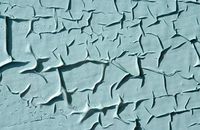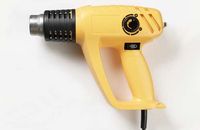There are three ways to remove paint from woodwork: sanding (messy, but effective on lightly painted surfaces), an electric hot air gun (quick over large areas), or chemical stripper (very messy but a good option if you are trying to budge awkward to reach or stubborn paint). You will need to wear safety goggles and a mask, plus rubber gloves if you’re using chemical strippers.
By Kirstie Allsopp
You Will Need
Sandpaper and sanding block or mechanical sander, or electric hot air gun, or chemical stripper
Safety goggles
Mask
Rubber gloves
Stripping knife
Wire wool
Dust sheets
Safety goggles
Mask
Rubber gloves
Stripping knife
Wire wool
Dust sheets

Step One: Check For Lead In Paint
Before you start stripping, be aware of the need to take precautions with lead-containing paint. Most paint before 1960 contained lead, so if you are removing paint from doors, banisters, windows and so on in an older home, or if you have a piece of old furniture,
Before you start stripping, be aware of the need to take precautions with lead-containing paint. Most paint before 1960 contained lead, so if you are removing paint from doors, banisters, windows and so on in an older home, or if you have a piece of old furniture,

Step Two: Begin Sanding
Hand sanding is suitable for small flat areas that don’t have much paint on them. Use a sanding block to make the job easier and sanding more even. For larger areas, you could hire a mechanical sander from HSS.
Hand sanding is suitable for small flat areas that don’t have much paint on them. Use a sanding block to make the job easier and sanding more even. For larger areas, you could hire a mechanical sander from HSS.

Step Three: Use An Electric Hot Air Gun
An electric hot air gun is a useful tool for removing paint from wood. You will need to keep the gun moving to avoid scorching the surface. Use a stripping knife to remove the paint as it lifts. Use the gun carefully to avoid heating anything other than the paint you’re removing.
An electric hot air gun is a useful tool for removing paint from wood. You will need to keep the gun moving to avoid scorching the surface. Use a stripping knife to remove the paint as it lifts. Use the gun carefully to avoid heating anything other than the paint you’re removing.

Step Four: Ventilate Well
Chemical strippers, available from DIY stores, are good for intricately carved wood. You will need to follow the manufacturer’s instructions as these vary. Make sure you keep the area you’re working in well ventilated. Protect the floor with dust sheets or thick newspaper.
To get a chemical stripper into nooks and crannies on intricate woodwork, use wire wool. Also, check the manufacturer’s instructions to see if you need to neutralise the stripped woodwork.
Chemical strippers, available from DIY stores, are good for intricately carved wood. You will need to follow the manufacturer’s instructions as these vary. Make sure you keep the area you’re working in well ventilated. Protect the floor with dust sheets or thick newspaper.
To get a chemical stripper into nooks and crannies on intricate woodwork, use wire wool. Also, check the manufacturer’s instructions to see if you need to neutralise the stripped woodwork.

0 komentar:
Post a Comment